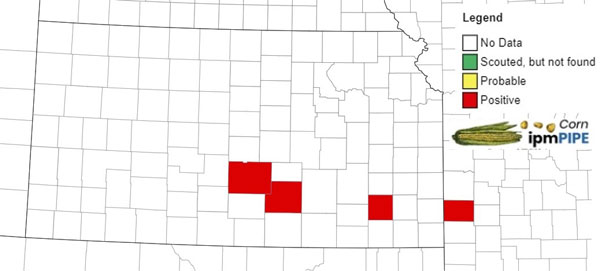Southern rust was just confirmed in Reno and Sedgwick counties in Kansas (Figure 1). Southern rust was first detected in southeast Kansas on July 2, and we continue to monitor the spread. At present, levels have remained low, however recent weather has been favorable for the disease in some parts of the state. Early detection of southern rust is crucial for successful management. Once pustules have been observed, the pathogen can reproduce rapidly if temperatures and humidity are high. Late-planted corn should be monitored closely, as the crop will be exposed to southern rust for a longer period than corn that was planted earlier.

Figure 1. Southern corn rust (Puccinia polyspora) in Kansas and surrounding states as of July 15, 2021. Source: https://corn.ipmpipe.org/southerncornrust/.
Considerations for treatment of southern rust
When deciding to spray for southern rust it is important to consider hybrid susceptibility, disease incidence (how many plants are affected), and corn growth stage. Infection early in the season on a susceptible hybrid, coupled with conducive weather conditions, pose the highest risk for yield loss.
Research has suggested that applications between VT to R3 have great potential for protecting corn yield, however if fungicide is applied between VT and R1, a second spray may be required to protect end of season yields. Most fungicides that are labeled for southern rust are also effective for gray leaf spot and will have residual activity for approximately three weeks after application, depending on the product. Application at dent (R5) are unlikely to provide yield benefit and the pre-harvest interval should be carefully observed. Fields that have not yet been sprayed should be monitored for disease development.
Efficacy ratings for corn fungicide management of southern rust have been compiled by a working group of corn researchers and can be found here: https://cropprotectionnetwork.org/resources/publications/fungicide-efficacy-for-control-of-corn-diseases
Identification of southern rust
Southern rust produces characteristic orange pustules filed with spores, primarily on the upper side of the leaf (Figure 2). If you run your finger across the pustules, the orange spores will be visible on your hand. The Kansas State Plant Diagnostic Lab (clinic@ksu.edu) can also confirm southern rust by observing spores under the microscope. Additional information about sending in a sample can be found here: https://www.plantpath.k-state.edu/extension/diagnostic-lab/.

Figure 2. Southern rust on corn. Photo courtesy of University of Nebraska, https://cropwatch.unl.edu/plantdisease/corn/southern-rust
For more information on identifying corn rusts, see K-State Research and Extension Bulletin MF3016, Corn Rust Identification and Management in Kansas.
Rodrigo Borba Onofre, Postdoctoral Research & Plant Pathology Extension Fellow
onofre@ksu.edu